Where The Trains Used To Go
|
Read more
at in70mm.com The 70mm Newsletter |
| Written by: Morten Skallerud | Date: November 30, 2003 |
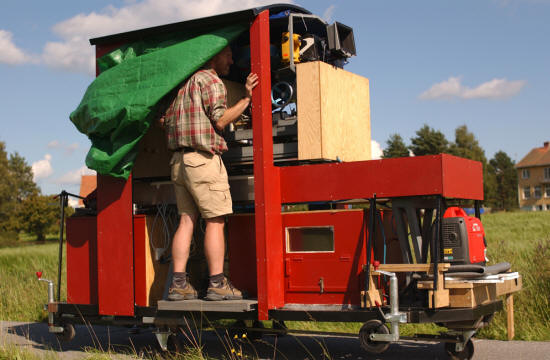 The
camera train. Morten Skallerud is seen to the left. Image by Odd Geir Sæther
/ Camera Magica. The
camera train. Morten Skallerud is seen to the left. Image by Odd Geir Sæther
/ Camera Magica.I love trains. I love Large Format, and I love making magic on film. "Where the Trains used to go" gave me an opportunity to combine the three for a 4½ minute 15perf 70mm "magic journey" along the remains of a closed-down narrow-gauge railway. "Where the Trains used to go" is the first Norwegian film shot in 15/70 Large Format. It was screened publicly for the first time at LFCA 2003 last May, where it was well received and was elected "Best Short film". But back home in Norway we have not been able to screen it for an audience yet, since Norway's only LF theatre has been closed for more than a year... Here are some glimpses from the making of our film - frame by frame. |
Further
in 70mm reading: "Where The Trains Used To Go". Credit list. Gallery: The Making of "Where The Trains Used To Go" A Year Along the Abandoned Road Morten Skallerud visits in70mm.com Internet link: |
A night shoot |
|
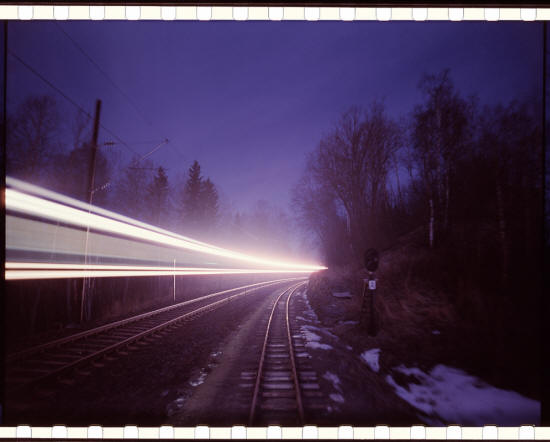 Frame
enlargement from night scene. Time exposure when another train passes by.
Image by Camera Magica. Frame
enlargement from night scene. Time exposure when another train passes by.
Image by Camera Magica.The crew of 4 gathers on the narrow-gauge museum railway track around 7 o'clock in the evening. It is the beginning of March, snow covers the Norwegian landscape and the sun has already set an hour ago. Soon it will be dark enough to start filming. Earlier in the day our friends from the Museum Railroad had helped us push up our camera locomotive, a rail trolley for the generator and a small passenger wagon with a wood stove inside it, which they are letting us use as a "base camp". We are about a kilometre away from the station area and stables now. All the rolling material stands nicely in a row - the red camera locomotive a bit ahead of the rest, placed on exactly the same spot as where we shot the last frame a week ago. The large camera, the theodolite and the computers were all placed back inside earlier today when there was still daylight and it was a bit warmer. We go through a long safety procedure to ensure that the camera works properly, then use the theodolite and a straight-forward-reference to adjust the pan angle for the first frame. We have just changed the sight point for our theodolite, so from now on we aim at the right side of the top of an easily recognisable pole 200 metres ahead. (Having no viewfinder on the camera, we also double check the framing using a Nikon F3 camera with a corresponding 24mm lens and angle marks on the ground glass.) Then we go through the tables for forward movement and panning, which I had prepared before we started using a series of measurement stills from last summer. We shall start by advancing the camera locomotive 92 centimetres per frame for the first 5 frames - then increase to 92,5 for the next 5 frames - then 93 for the next 5 and so on till we reach 100 centimetres per frame. Then we will stay at 100 centimetres per frame for at least another 2 or 3 shooting nights. At the same time we will be panning the camera slowly towards the left to prepare for the long curve we are moving into. Panning speed is now 0.05 degrees per frame, which we will increase gradually to 0.10 degrees. |
|
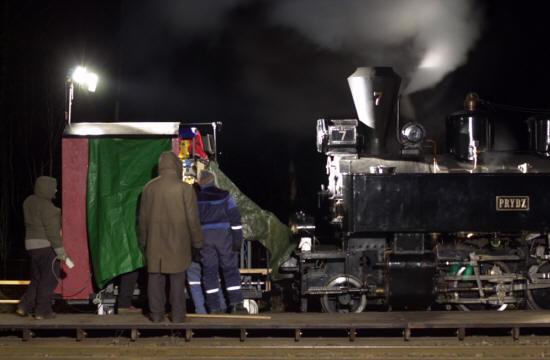 Narrow
guage steam engine meets Morten Skallerud's camera train. Image by Torstein
Nodland / Camera Magica. Narrow
guage steam engine meets Morten Skallerud's camera train. Image by Torstein
Nodland / Camera Magica.Clouds cover the night sky. There is no moon behind them tonight, so they pick up light mainly from the scattered houses and sparsely lit roads nearby. It is quite dark, but not so dark that I cannot see the snow covered landscape with my own night vision. A few street lamps are visible in the distance. Comparing with last night and the test stills I took then, I decide to expose 30 seconds per frame. It is too long to keep a 1-frame-per-minute shooting cycle, but I would rather shoot fewer frames per night than underexpose. We shoot the slate and some test frames to ensure that everything works properly, then we are ready to make today's first effective frame. The electric generator grumbles nicely, the long electric cable lies ready to be pulled after us, we are in position with the pan angle double checked, the camera base is perfectly level and the internal dolly is on start position. Camera, computers and crew are ready. The time is 20.32. Still we wait for another few minutes, because a train is expected to pass on the "big" railway line beside us around 20.39. I want to expose the first frame while that train is passing. Passing trains make those nice lines of light through the frame, and also the light flash helps to smooth out the cut from the previous shooting night. The main line train comes up from behind. I press the exposure button. The Kuper control turns off the work light, starts moving the inner camera dolly slowly forwards and opens the camera shutter. We are exposing today's first effective frame! After 30 seconds the shutter closes, the inner dolly stops and moves back to its start position, and the work light comes on again. Eivind Natvig and Ninon Onarheim are responsible for the forward move of the locomotive, they walk behind and steer it with an electric motor and a special measuring device. Since we are still moving uphill they also help to speed up the process by pushing a bit extra, manually. When the locomotive has reached its next shooting position, they shout "Ready!". |
|
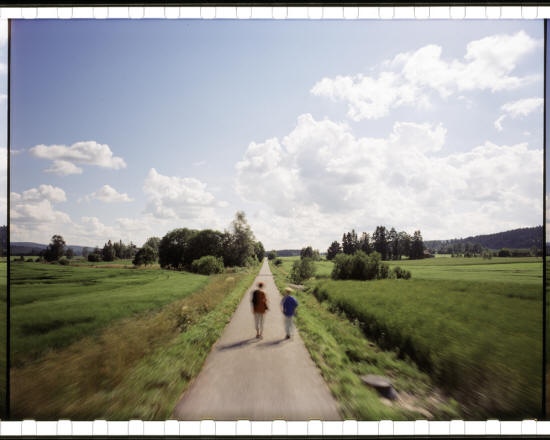 The
old trainline, now a walking path. Rails have been removed. IMAX frame blow
up. Image by Camera Magica. The
old trainline, now a walking path. Rails have been removed. IMAX frame blow
up. Image by Camera Magica.Dennis Røller and I stand inside the main room at the rear of the locomotive, one on each side of the inner camera dolly. As soon as we are in position, Dennis adjusts the levelling actuators till both axes are perfect. Myself, after having adjusted the angle measure for the next frame, I look through the theodolite telescope and adjust the Moy head till the centre-cross lines up with the pole top in the distance again. When Dennis has also said "Ready!" and the time is right, I push the exposure button again. We are exposing today's second effective frame of film... It goes on like this for a long time: 30 seconds exposure while the camera moves slowly forwards. - Work lights on, camera dolly back again. - Locomotive forward - Level and pan adjustments. Work lights off - 30 second exposure - Work lights on, locomotive forward, adjustments. Work lights off - 30 second exposure - Work lights on, locomotive forward, adjustments. After having been through this process 24 times, we have made one second of film. Twice per hour the scheduled trains pass on the main line beside us. We make sure that it happens during exposure. After 00.39 there are no more passing trains - except maybe a freight train or two. But we never know when they will pass - so we take a break and a night meal inside the passenger wagon. After the break the night light seems a bit weaker, so we increase the exposure to 40 seconds per frame. And lightly falling snow makes extra work for us to keep the lens clean. It is 3 o'clock before we wrap and the daytime watch takes over. Tonight we have exposed 7½ seconds of film, and we have reached a total of 1 minute and 25 seconds. This was our 17th shooting day. |
|
Technique for a nature animation film |
|
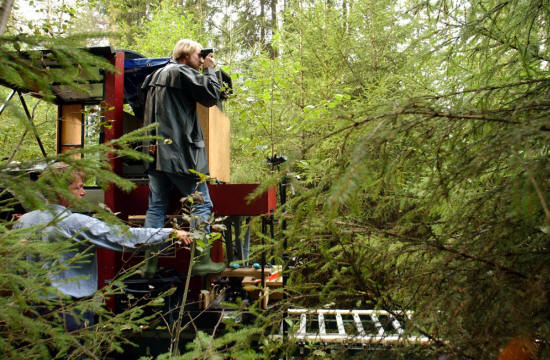 Shooting
in the forest where the train used to go. Note the tracks. Image by Odd Geir
Sæther / Camera Magica. Shooting
in the forest where the train used to go. Note the tracks. Image by Odd Geir
Sæther / Camera Magica.Mats Erixon, in Sweden, had a primitive 15/65 single frame camera which he had used earlier as an optical printer camera. It had no viewfinder and was as far as you could come from being a reliable, versatile easy-to-use location camera. But it worked, and it was affordable! Gustaf Mandal, at Filmsmedjan, did some beautiful pieces of engineering work fitting Mitchell magazines, a Hasselblad mount, a matte-box with a safety shutter and filter holder and various other central details. So together with Mats' Kuper control this camera would do single-frame shooting the way we needed. We had made a 5perf 70mm film called "A Year along the Abandoned Road" some years ago using much the same nature animation technique, - so we knew the basics and had some bits of equipment we could use. But this time the camera was a lot heavier, we should move along a variety of grounds and pass a couple of solid obstacles. We also needed movement blur when moving fast. So we had to build a new and more comprehensive camera tracking system before the shooting could start. Frode Wik of Wakeman Film, Morten Johansen of Norsk Hardkrom, Dennis Røller and I myself made up the central construction team. |
|
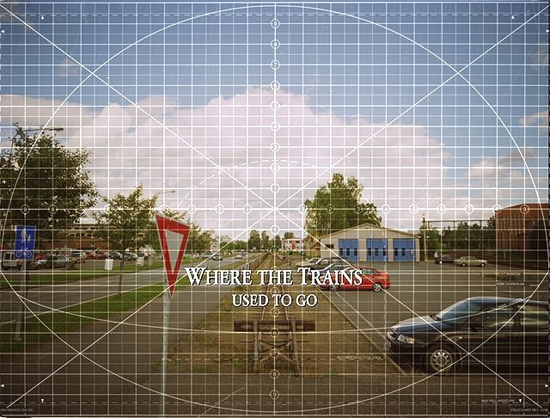 IMAX
/ Imax Dome chart. Image by Camera Magica. IMAX
/ Imax Dome chart. Image by Camera Magica.We built a solid "Camera Locomotive" in steel and aluminium with red wooden outer walls, - 3,5 meters long (11 ½ feet) by 2,6 meters tall (8½ feet) and with 3 sets of wheels: Railway wheels, wheels for asphalt, and wheels that could be used with the flexible rails we had made for the previous film. Inside the locomotive we made places for two standing persons and different kinds of equipment, plus the most central part: an "Inner Dolly" which could be moved very precisely forward and backward up to 128 cm (a bit more than 4 feet) on linear bearings. On this "Inner Dolly" we made an electronic fine-levelling system with 4 actuators, that supported a Moy head with the camera on it. A theodolite (land measuring instrument) was placed beside the camera as an essential panning and aiming device. Heaters were installed to maintain the correct temperature during the cold period. All electrical equipment was run on 220V DC, which would be supplied either by generators or from nearby houses. Lots of cable was needed .... This double system could be used in a variety of ways, and even during the shooting period new constructions were made, or old ones modified. Single-frame technique gave us many ways to expose each frame. For day scenes we chose exposure times between 1/15 sec and 10 seconds per frame, always using a nice T stop around 11 and combining with more or less heavy ND filters. For night scenes exposure times varied between 10 and 60 seconds at full aperture 2.8 - except for the artificially lit pixilation scene at the station which we took at 2 seconds and 5.6. Raw film was Eastman 5245 for the day scenes and Vision 500T for night. |
|
Finishing |
|
 Drawing
of the camera train. Image by Camera Magica. Drawing
of the camera train. Image by Camera Magica.Most of the time, the rural Norwegian landscape and the camera's train like moves were the main content of our pictures. Though sometimes we needed to control the movements of people and objects, - which gave us an opportunity to use our animation skills a bit. This was quite fun! In fact, you can animate people, cars and locomotives using much of the same principles as for puppet films or cartoons.... All in all, we spent 34 shooting days (and nights) spread over a year, with a crew of 3 - 4 people for a 4½ minute film. Not to mention numerous days with technical work etc., and a lot of stand-by for the weather etc., etc... Lots of people had been really positive and helpful - not the least everyone at the beautiful little Tertitten Museum Railway where we did most of the shooting. Thanks to all these, a wonderful crew, the Norwegian film funding sources, our co-operating partner Grenzeløs and everyone who gave us good deals and did lots of unpaid work etc., we were able to get material on film which was very close to how I wanted it to be. Norway's most famous jazz composer and saxophonist Jan Garbarek created a really magical piece of music for the film, and Jan Lindvik made the rest of the sound track very well at The Chimney Pot, Oslo. Re-recording was done by Tormod Ringnes, partly at TCP and partly in the Imax Theatre. |
|
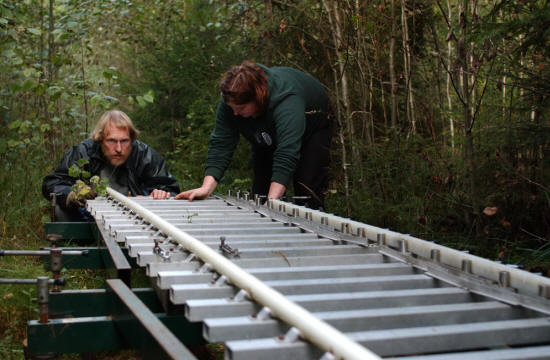 Absolute
precision is required when adjusting the tracks for the camera train. Image
by Odd Geir Sæther / Camera Magica. Absolute
precision is required when adjusting the tracks for the camera train. Image
by Odd Geir Sæther / Camera Magica.Gulliver in Paris, who had also done the lab work during shooting, did the lab. Post production with Andrew Oran of Lynbrookfilm as supervisor. They did a beautiful job and gave me wonderful service all the way, - even though this was a small film with a very limited lab budget! "Where the Trains used to go" has been finished for half a year now. The budget is more than used up, and I have become a poor but quite happy film director. The first official screening was at LFCA 2003 (Large format film festival in Los Angeles in May), where it was voted Best Short Film! In September it was screened and very well received at the GSTA conference and trade show, which is the world's biggest event for Large format cinemas. A number of theatres have shown their interest in the film. But what about Norway? The Imax Theatre in Oslo was one of our partners during the production, but they have kept closed to the public since July 2002. Nobody is sure yet when and if it will be re-opened. So: Indeed it was possible to make a large-format film in Norway. But will it ever be possible to screen the film for a Norwegian audience? We really hope so! |
|
|
Go: back
- top - back issues
- news index Updated 22-01-25 |
|
